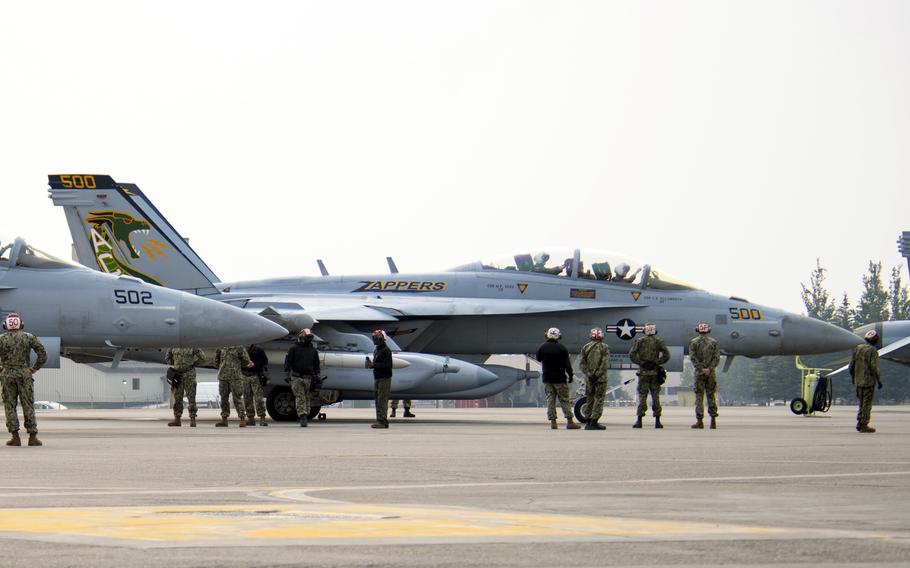
A U.S. Navy EA-18G Growler assigned to Electronic Attack Squadron 130 takes part in Red Flag drills in Alaska in 2022. (Ryan Lackey/U.S. Air Force)
TACOMA, Wash. — Search crews have located the wreckage of an EA-18G Growler jet that crashed near Mount Rainier, Navy officials said Wednesday.
“The status of the two crew members is unknown,” said Cmdr. Beth Teach, a Navy spokeswoman in San Diego.
The wreckage was spotted at about 12:30 p.m. Wednesday on a steep ridge that cannot be reached yet on foot or by vehicle, she said. Search teams are making plans to climb to the crash site Thursday as soon as a safe route in the snow and rain can be mapped out.
An emergency operations center has been established at Naval Air Station Whidbey Island, home to all but one Navy Growler squadron. The Growler that crashed was assigned to Electronic Warfare Squadron 130, nicknamed “Zappers.”
The two-seat jet crashed at about 3:23 p.m. Tuesday, the Navy said.
Navy P-3 Orion and P-8A Poseidon reconnaissance planes from NAS Whidbey Island flew over large swaths of the region on the southwestern border between Washington and Oregon looking for the crash site.
A Navy MH-60S Sea Hawk search and rescue helicopter and other helicopters from nearby Joint Base Lewis-McChord also took part in the search for the Growler crash or the crew near the 14,411-foot Mount Rainier.
Teach said the search crews were hampered by unsure footing in the snow and rain as they often hiked with little visibility during the little more than nine hours of daylight.
“Responders are facing mountainous terrain, cloudy weather, and low visibility as the search is ongoing,” she said.
NAS Whidbey Island is on the Puget Sound northwest of Seattle, about 100 miles from Mount Rainier. Lewis-McChord is located about 35 miles northwest of the mountain.
The Navy has not yet determined whether the pilots were flying VR 1355 — a military training route nicknamed “The Million Dollar Ride” through the mountainous area popular with Growler pilots for its challenging terrain, Teach said. Several videos of Growler pilots going through the turns, climbs and dives have been posted to YouTube. “The Million Dollar Ride” draws civilian plane-spotters looking to see military aircraft flying at high speed and low levels. Alerts of planes flying the route are shared on social media, especially Reddit.
High-speed, low-level flying is part of the training for Growler crews. The aircraft are used to knock out enemy radar and anti-aircraft batteries at the beginning of an airstrike.
The Growler has a digital radar warning receiver, which provides 360-degree readings to identify threats, and an integrated jamming system that allows the jet to attack radar installations attempting to track incoming aircraft.
The Electronic Attack Squadron 130 had deployed as part of the USS Dwight D. Eisenhower strike group, which returned in July to Norfolk Naval Station, Va. The strike group spent nine months in the Middle East, guarding military and commercial vessels and fending off Houthi missile and drone attacks in the Red Sea and Gulf of Aden.
The Growler was developed to replace the EA-6B Prowler aircraft, which entered service in 1971 and retired in March 2019.
The last fatal crash involving a NAS Whidbey Island-stationed jet happened March 11, 2013, according to Michael Welding, spokesman for the air station.
A three-seat EA-6B Prowler from Electronic Attack Squadron 129 was on what the Navy termed a “routing training” flight when it crashed in a rural area about 50 miles west of Spokane.
All three crew members were killed: Lt. j.g. Valerie Cappelaere Delaney from Ellicott City, Md., Lt. j.g William Brown McIlvaine III from El Paso, Texas, and Lt. Cmdr. Alan Patterson from Tullahoma, Tenn.
A Navy investigation released in 2014 blamed pilot error, saying Delaney had flown the jet too low, causing a ground collision. It also faulted the Navy for Patterson’s “accelerated” designation as a flight instructor. Investigators said he did not have enough time flying with younger pilots to be able to order Delaney to make a course correction before the impact.